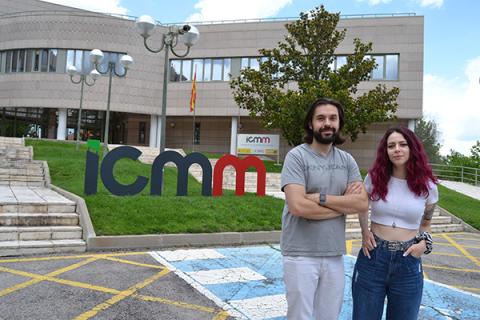Felipe Gándara and Clara López win the Sagrario Martínez Carrera and Xavier Solans prizes from the Spanish Chemical Society
The researchers work at Multifunctional and Supramolecular Materials Group, at ICMM-CSIC.

The Specialized Group of Crystallography and Crystal Growth (GE3C) of the Royal Spanish Societies of Physics (SREF) and Chemistry (RSEQ) has awarded the Sagrario Martínez Carrera Prize "ex aequo" to researcher Felipe Gándara, and the Xavier Solans Prize to scientist Clara López. Both belong to the Multifunctional and Supramolecular Materials Group at the Institute of Materials Science in Madrid (ICMM), CSIC.
The Sagrario Martínez Carrera Prize, celebrating its second edition, aims to "recognize the careers of relevant crystallographers in Spain in intermediate stages of their careers." The GE3C jury has decided to award it "ex aequo" to Felipe Gándara, from the ICMM, along with Guillermo Mínguez, for their contributions "in the characterization and design of these materials [MOFs, Metal-Organic Frameworks] using crystallographic techniques."
According to the institution's note, the contribution of Gándara and Mínguez "is reflected in their leadership in highly impactful publications and participation in patents." Additionally, the jury has valued how both scientists have contributed "to the development and promotion of crystallography in Spain through their dedication to teaching, outreach, and participation in organizing events" related to this field.
On the other hand, Clara López, a predoctoral researcher at ICMM, has been awarded the XII Xavier Solans-Bruker Prize, created to recognize relevant scientific work in the field of Crystallography or Crystal Growth published by a young person. In her case, the award comes for her publication in the prestigious journal JACS titled 'Heterometallic Molecular Complexes Act as Messenger Building Units to Encode Desired Metal-Atom Combinations to Multivariate Metal−Organic Frameworks.'
The prize jury highlights that López's work successfully develops new synthetic routes for the controlled synthesis of highly complex multimetallic functional materials with specific combinations of metal elements. Specifically, they have noted "not only the difficulty of synthesizing such compounds but also the detailed study carried out to structurally characterize the complicated systems obtained."
"The awarded work focuses on the development of a new strategy for obtaining multimetallic functional materials of the MOF (Metal-Organic Framework) type," explains the researcher herself. "To this day, these types of materials present a great challenge both in terms of synthesis and characterization, due to the difficulty of incorporating different elements in the same structure in a controlled manner. That is why the ability to precisely incorporate combinations of metal elements is of great interest since it would open up new pathways to introduce specific codes of chemical information into structures," continues the young researcher.
With this starting point, the awarded work, co-authored with Gándara, addresses the mentioned challenge with a novel methodology: "We use heterometallic complexes as molecular precursors for the synthesis of MOFs with specific sequences of metal elements. These precursors have a transmissive character of chemical information, which is why they are called mBUs (messenger building units)," López explains. She indicates that thanks to this new methodology, "two MOFs based on gallium-nickel and gallium-cobalt combinations were obtained, in which a chemical code was successfully inserted using mBUs with the same metal combination." She adds this summary: "The awarded work has served to demonstrate new synthetic routes that allow the design of specific sequences or chemical environments and their insertion into complex networks. It is expected that this will be of great utility and interest in different fields such as catalysis, as specific active sites could be designed."
Instituto de Ciencia de Materiales de Madrid (ICMM)
Sor Juana Ines de la Cruz, 3
Cantoblanco, 28049
Madrid, España
Telephone: (+34) 91 334 90 00
Email: @email
Communication Office: @email

Acknowledge the Severo Ochoa Centres of Excellence program through Grant CEX2024-001445-S/ financiado por MICIU/AEI / 10.13039/501100011033

Contacto | Accesibilidad | Aviso legal | Política de Cookies | Protección de datos